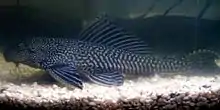Pterygoplichthys pardalis
Pterygoplichthys pardalis, the Amazon sailfin catfish, is a freshwater tropical fish in the armored catfish family (Loricariidae). It is one of a number of species commonly referred to as the common pleco or "leopard pleco" by aquarists.
| Pterygoplichthys pardalis | |
|---|---|
 | |
| Scientific classification | |
| Kingdom: | Animalia |
| Phylum: | Chordata |
| Class: | Actinopterygii |
| Order: | Siluriformes |
| Family: | Loricariidae |
| Subfamily: | Hypostominae |
| Tribe: | Pterygoplichthyini |
| Genus: | Pterygoplichthys |
| Species: | P. pardalis |
| Binomial name | |
| Pterygoplichthys pardalis (Castelnau, 1855) | |
| Synonyms | |
| |
Description
The species will grow to a maximum length of 49 centimetres (19 in) SL and reach a weight of 310 g.[1]
It is sometimes confused with the Hypostomus plecostomus (another armored catfish known as the "common plecostomus"). The two species can be distinguished by their number of dorsal rays. P. pardalis has 11–13, while the H. plecostomus has only 5–8 dorsal rays. There is also an albino color variation of this species, usually referred to as an "Albino Plecostomus".
Distribution and habitat
The species is native to the Amazon River Basin of Brazil and Peru, preferring pH ranges of 7.0–7.5. It is a facultative air breather; although normally a bottom-dwelling fish, it has the ability to breathe air from the surface of the water during dry periods or when dissolved oxygen is too low. The Amazon sailfin catfish has been introduced to a number of countries outside its native range.[1] It is recorded in the Marikina River in the Philippines and known as the "janitor fish", where it has become a local pest and sold in bulk, in efforts to eliminate the fish.[2][3][4][5] In the United States, invasive populations of sailfin catfishes like the Amazon sailfin catfish have been observed to be ecologically detrimental, as they disrupt aquatic food chains, decrease the abundance of native aquatic species, and degrade aquatic plants or banks of waterbodies through burrowing and tunneling.[6]
References
- Froese, Rainer and Pauly, Daniel, eds. (2017). "Pterygoplichthys pardalis" in FishBase. 12 2017 version.
- "New Philippine record of south American sailfin catfishes (Pisces: Loricariidae)" (PDF). Zootaxa. Retrieved August 28, 2013.
- American Chronicle | Janitor Fish Threatens Asia's Largest Marshland Archived March 21, 2008, at the Wayback Machine
- "Embryonic and larval development of the suckermouth sailfin catfish Pterygoplichthys pardalis from Marikina River, Philippines".
- "Pterygoplichthys pardalis, (Castelnau, 1855) Amazon sailfin catfish, Philippines country information". FishBase.
- Hoover, Jan; Killgore, K; Cofrancesco, Alfred (February 2004), "Suckermouth Catfishes: Threats to Aquatic Ecosystems of the United States?", Aquatic Nuisance Species Research Program Bulletin, 4 (1): 1–9